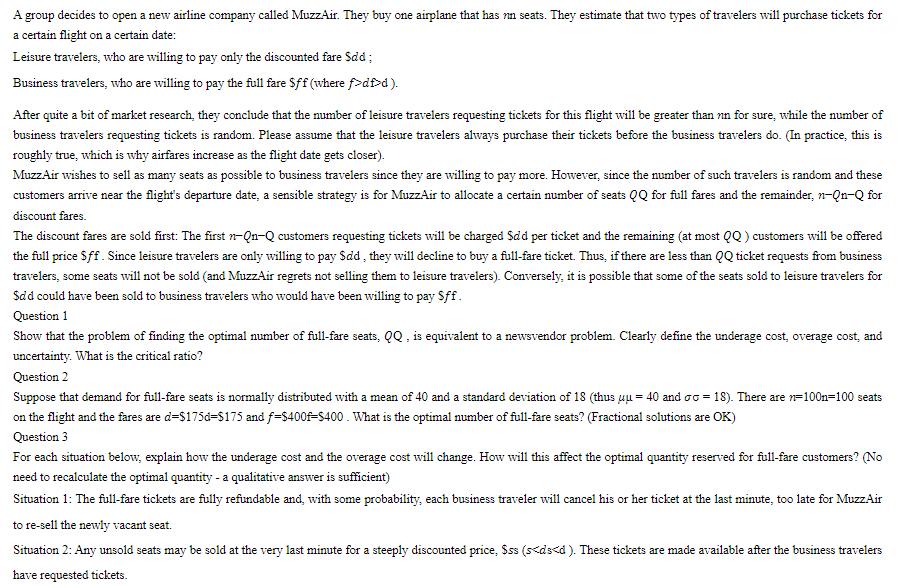Answered step by step
Verified Expert Solution
Question
1 Approved Answer
A group decides to open a new airline company called MuzzAir. They buy one airplane that has nn seats. They estimate that two types

A group decides to open a new airline company called MuzzAir. They buy one airplane that has nn seats. They estimate that two types of travelers will purchase tickets for a certain flight on a certain date: Leisure travelers, who are willing to pay only the discounted fare Sdd; Business travelers, who are willing to pay the full fare Sff (where f>df>d). After quite a bit of market research, they conclude that the number of leisure travelers requesting tickets for this flight will be greater than nn for sure, while the number of business travelers requesting tickets is random. Please assume that the leisure travelers always purchase their tickets before the business travelers do. (In practice, this is roughly true, which is why airfares increase as the flight date gets closer). MuzzAir wishes to sell as many seats as possible to business travelers since they are willing to pay more. However, since the number of such travelers is random and these customers arrive near the flight's departure date, a sensible strategy is for MuzzAir to allocate a certain number of seats QQ for full fares and the remainder, n-Qn-Q for discount fares. The discount fares are sold first: The first n-Qn-Q customers requesting tickets will be charged Sdd per ticket and the remaining (at most QQ) customers will be offered the full price $ff. Since leisure travelers are only willing to pay Sad, they will decline to buy a full-fare ticket. Thus, if there are less than QQ ticket requests from business travelers, some seats will not be sold (and MuzzAir regrets not selling them to leisure travelers). Conversely, it is possible that some of the seats sold to leisure travelers for Sad could have been sold to business travelers who would have been willing to pay Sff. Question 1 Show that the problem of finding the optimal number of full-fare seats, QQ, is equivalent to a newsvendor problem. Clearly define the underage cost, overage cost, and uncertainty. What is the critical ratio? Question 2 Suppose that demand for full-fare seats is normally distributed with a mean of 40 and a standard deviation of 18 (thus uu = 40 and oo = 18). There are n=100n=100 seats on the flight and the fares are d=$175d=$175 and f-$400f-$400. What is the optimal number of full-fare seats? (Fractional solutions are OK) Question 3 For each situation below, explain how the underage cost and the overage cost will change. How will this affect the optimal quantity reserved for full-fare customers? (No need to recalculate the optimal quantity - a qualitative answer is sufficient) Situation 1: The full-fare tickets are fully refundable and, with some probability, each business traveler will cancel his or her ticket at the last minute, too late for MuzzAir to re-sell the newly vacant seat. Situation 2: Any unsold seats may be sold at the very last minute for a steeply discounted price, $ss (s
Step by Step Solution
★★★★★
3.39 Rating (155 Votes )
There are 3 Steps involved in it
Step: 1
ANSWER Question 1 The problem of finding the optimal number of fullfare seats can be modelled as a newsvendor problem The overage cost is the cost of ...
Get Instant Access to Expert-Tailored Solutions
See step-by-step solutions with expert insights and AI powered tools for academic success
Step: 2

Step: 3

Ace Your Homework with AI
Get the answers you need in no time with our AI-driven, step-by-step assistance
Get Started


